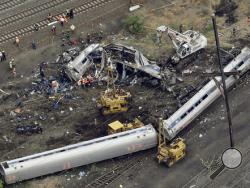NEW YORK (AP) — The National Transportation Safety Board is scheduled to meet to detail the probable cause of last year's deadly Amtrak derailment in Philadelphia, a day after a U.S. official briefed on the investigation revealed that the engineer was distracted by radio transmissions.
The NTSB will meet on Tuesday in Washington to vote on the probable cause of the May 12, 2015 crash that killed eight people.
Engineer Brandon Bostian told investigators after the derailment that he remembered radio traffic that night from a commuter train operator who said a rock had shattered his windshield. The official did not say whether those were the transmissions that distracted Bostian, but the engineer did not speak about any other radio chatter when he was interviewed by federal investigators, according to material released previously by the NTSB.
The official was not authorized to comment publicly because of the ongoing probe and spoke to The Associated Press on the condition of anonymity.
NTSB spokesman Peter Knudsen said the agency would not comment ahead of Tuesday's hearing.
Bostian's attorney did not immediately return an email sent after business hours on Monday. An Amtrak spokesman said the agency will have a comment after the hearing.
The official briefed on the report's findings on Monday said that investigators also believe there were some issues with the train's emergency windows and several people were killed because they were ejected through them.
The investigation found that police transported many of the injured people to the hospital, instead of waiting for ambulances, the official said. The NTSB is expected to recommend that engineers be retrained about distractions and also recommend that the city wait for ambulances to take injured people to the hospital at mass-casualty incidents.
Just 23 of the 185 hospitalized in the crash were taken in an ambulance, according to NTSB data. The rest were taken by other means, such as city buses, police cars or vans. The NTSB found that just three of the 43 seriously injured passengers had an ambulance transport chart.
The city's office of emergency management is finalizing a revised mass-casualty plan that will continue to allow police to transport victims, but will aim for better coordination with the fire department, said spokeswoman Noelle Foizen.
Investigators are looking into why the train from Washington to New York City was going double the 50 mph limit around a sharp curve about 10 minutes after leaving Philadelphia's 30th Street Station.
Early in the investigation, the NTSB focused on whether the Amtrak train had been hit with a rock or other projectile minutes before the crash.
Bostian told investigators that he was concerned about the welfare of the commuter train's engineer and "a little bit concerned" for his own safety, but he never indicated in either NTSB interview that his train had been struck too.
Bostian, regarded by friends for his safety-mindedness and love of railroading, has been suspended without pay since the crash. A letter from Amtrak in the NTSB files shows he was suspended for speeding.
___
Michael R. Sisak in Philadelphia contributed to this report.

